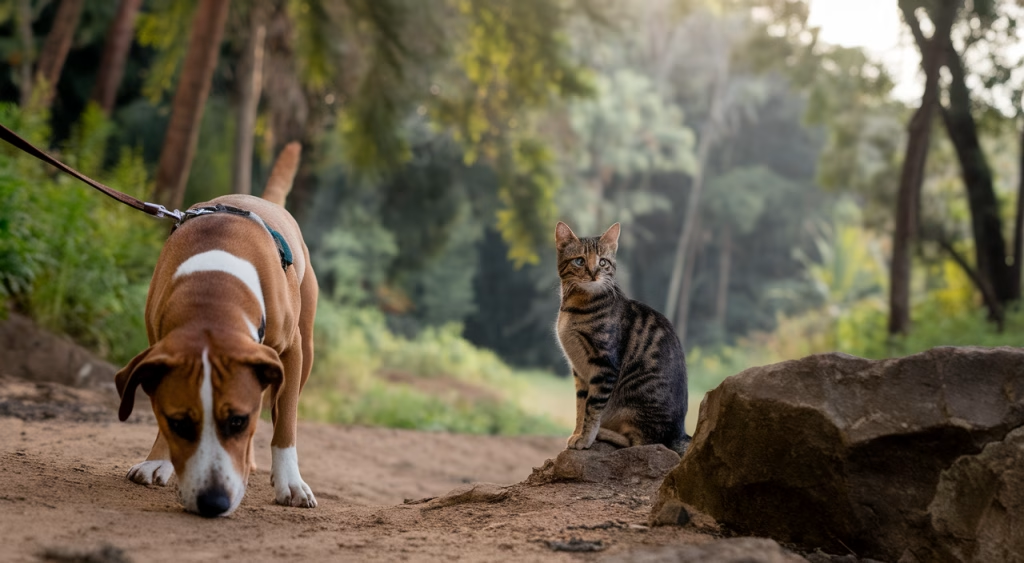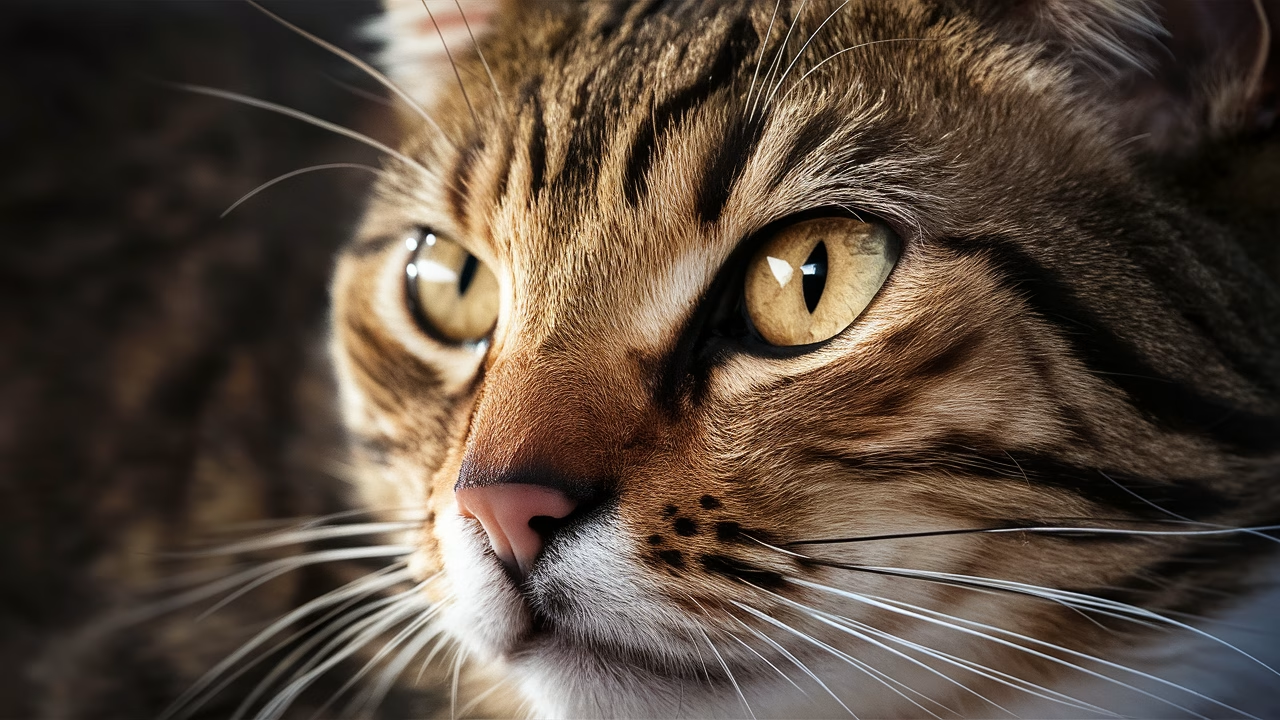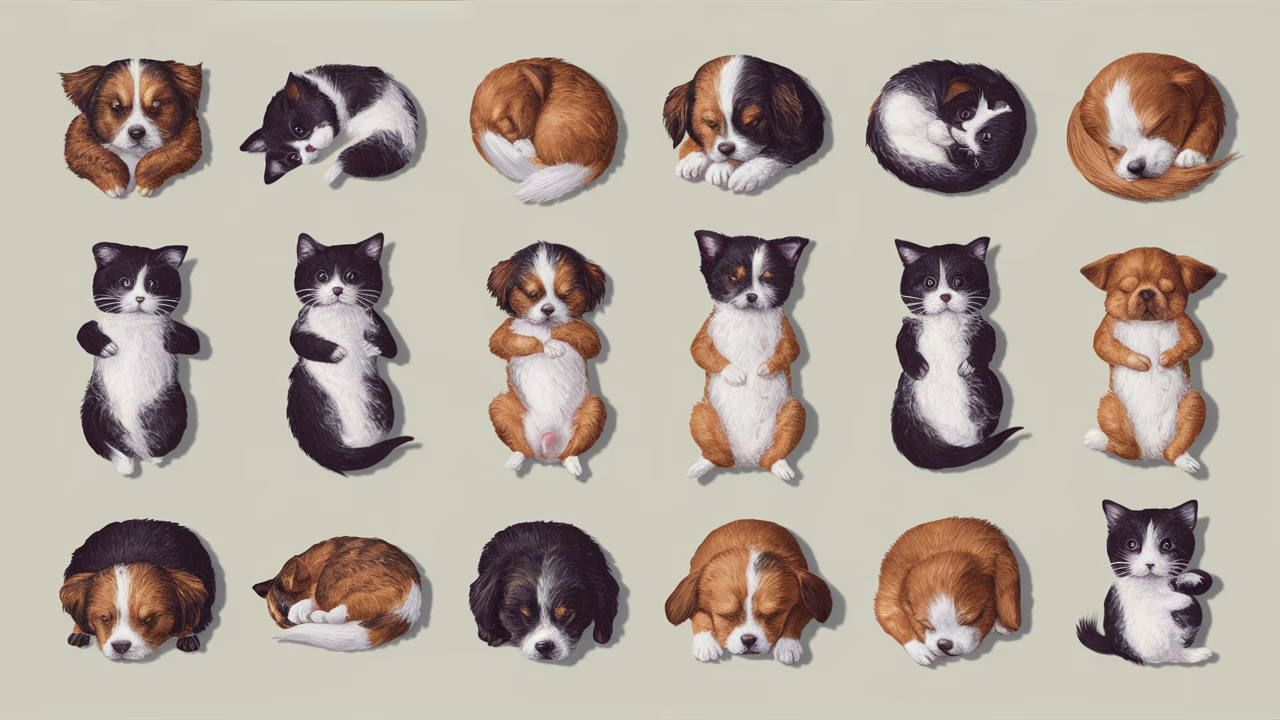What are the strangest animal behaviors pet owners should watch for?
From third eyelids to ultraviolet visions and unique nose prints, our pets harbor fascinating secrets. These weird animal facts aren’t just trivia—they’re veterinary clues that can dramatically transform how we care for our furry companions. What lies beneath those adorable ears and wagging tails? Let’s explore these hidden mysteries together.
- Your cat’s third eyelid isn’t broken—it protects their eyes during rest or illness.
- Dog noses have unique prints, just like fingerprints – and they’re scent-detecting supercomputers.
- Cats can’t taste sweets due to a meat-focused evolutionary path.
- Weird sleeping positions often reveal early signs of illness or pain.
- Animal ears are communication tools and health indicators you shouldn’t ignore.
- Time perception in pets is vastly different, affecting routines and emotional well-being.
Understanding these unique behaviors empowers pet owners with proactive care and builds a stronger bond with our furry companions.
The Astonishing World of Pet Behaviors
If pets came with instruction manuals, most of us would need thousand-page volumes. But buried in their seemingly odd behaviors are brilliant clues—clues shaped by animal adaptation across centuries of survival and companionship.
The Mysterious Third Eyelid in Cats
Ever see a pale, veil-like membrane slide across your cat’s eye? That’s the nictitating membrane, or what many call the third eyelid. Unlike humans, cats evolved this extra protection to keep their deadly-precise vision sharp and safe from debris, especially when hunting or resting lightly.
It’s usually tucked out of sight, but when your cat is ill, sleepy, or recovering, their third eyelid might become more noticeable. Don’t panic! It’s not always a vet emergency but worth observing if it lingers.
Dogs Have Nose Prints More Unique Than Fingerprints
Your dog’s nose is more than a snout for sniffing—it’s nature’s most sophisticated identification system. The patterns and creases in every dog’s nose are so unique they can be used for identification purposes.
From a veterinary perspective, their wet noses aren’t just cute—they’re smell-capturing systems that demonstrate incredible animal behaviors. With up to 300 million olfactory receptors (humans have 5 million), canines experience smell like we experience color.
Imagine your dog reading a full crime novel of scents while sniffing a lamp post—it’s their version of Netflix, GPS, and social media combined.
Cats Can’t Taste Sweetness
Cat behaviors around food often bewilders pet owners. The truth? Cats lack sweet-taste receptors entirely. Their evolution as obligate carnivores left them with zero need to process sugars. So when you offer them a strawberry and get an offended blink in return, now you know: that taste doesn’t exist for them.
This weird animal fact steers many veterinarians to advise meat-based treats and discourage sweet human snacks that hold no flavor or benefit for felines—in fact, some can be toxic.
Decoding Your Pet’s Communication
Just because they don’t talk doesn’t mean they aren’t saying something. Understanding your pet’s communication begins with observing the little things: ears, eyes, posture, and even when they seem to be ‘doing nothing.’
What Does It Mean When Pets Stare at Empty Corners?
Ever catch your cat staring at nothing for minutes? They’re probably watching dust motes, shifting air currents, or UV patterns—one of the most fascinating weird animal facts.
Cats can perceive ultraviolet light—a spectrum we humans can’t see. Their supercharged retinas can detect movement and patterns entirely invisible to us. So when your feline stares into a corner, don’t call the ghost hunters—it’s just science at work.
Dog and Cat Ears: Emotional Roadmaps
Dog behaviors include swiveling their ears like satellite dishes tuned to your emotions, surroundings, or discomfort deep inside. Cat ears? They’re emotional antennas that reveal their inner state.
| Pet Ear Movement | Possible Meaning |
|---|---|
| Dog ears back | Submission, fear, or affection |
| Dog ears up | Alert, excited, curious |
| Cat ears rotating rapidly | Overstimulated or anxious |
| Ears flattened | Fear, aggression, or illness |
Vets learn to decode these subtle signposts long before a blood test or thermometer is needed.
Veterinary Insights for Pet Owners
Here’s where practical knowledge meets everyday action. Strange sleeping positions, wound-licking, or water slurping styles sometimes raise eyebrows—but each tells a veterinary story. Through veterinary experience, we’ve come to recognize these animal behaviors as diagnostic goldmines.
Your Pet’s Sleeping Style Tells a Health Story
Is your dog always rolled belly-up like a spilled burrito? That’s a sign of deep trust, vulnerability, and temperature regulation comfort. Curling tightly? It may signal discomfort or fear—one of the most telling unusual pet behaviors.
Cats often choose elevated spots or tight corners. This isn’t snobbery—it’s encoded safety instincts through animal adaptation. But sudden changes could indicate pain or stress reactions.
Wet Dog Kisses: Cute or Clinical?
While we wouldn’t suggest replacing antiseptics with dog drool, it’s true—canine saliva does carry light antibacterial properties. Dogs instinctively lick wounds (theirs or others’) as part of natural care. But remember—they’re still dogs, and licking too much can delay healing or introduce infection.
Understanding Unusual Pet Behaviors for Better Care
Unusual pet behaviors—whether in drinking, movement, or schedule—often carry warning flags or hidden messages about health. These weird animal facts help pet owners recognize when something’s amiss.
Pets Experience Time Differently
To your dog, your 8-hour shift might feel like 24. Time perception in dogs and cats is deeply sensory-based and emotion-driven. Every absence or reunion is exaggerated through this distortion.
This is also why establishing a routine is critical. Morning walks, feeding times, or bedtime rituals offer grounding, especially for pets with separation anxiety.
How Pets Drink is a Physics Lesson
The next time your dog paws at you after guzzling water, realize they just engineered a column of liquid with their backward-lapping tongue—capturing and biting the centrifugal stream like a pump. Cats do the same but more delicately, barely piercing the surface to let physics handle the rest.
Different technique, same goal. But it explains why one might leave the floor soaked and the other keeps it spotless.
Revealing Your Pet’s Hidden Abilities
Still think animals are predictable? Think again. These amazing traits are the result of animal adaptation sharpened over thousands of years, creating some of the most intriguing weird animal facts.
Hidden Talent: Pain Masking
Like tigers in the wild, our pets hide discomfort to avoid appearing weak. That means subtle shifts—less energy, skipping stairs, leaving food untouched—might be quiet SOS signals.
One feline patient of mine, typically aloof, started curling under her owner’s bed daily. No noise, no limp, but an ultrasound revealed early kidney issues. Observing change is often more telling than hearing complaints in the pet world.
Manatees Are Closely Related to Elephants: The Surprising Evolutionary Connection
Using Knowledge for Proactive Care (Comparative Guide)
| Observation | Possible Cause | Action Steps |
|---|---|---|
| Sudden behavior change | Pain, stress | Schedule a check-up with your vet |
| New sleeping pattern | Chronic discomfort | Monitor for other signs; assess joint issues |
| Constant water licking | Dehydration or kidney problem | Generate clean water source & seek lab tests |
| Ignoring meatless diets | Natural taste disinterest | Offer species-appropriate nutrition |
Frequently Asked Questions
- Why does my cat’s third eyelid suddenly appear?
It can signal fatigue or illness but also appears during deep sleep or grooming. If persistent, contact a vet. - Can my dog really smell emotions?
While not emotions per se, dogs detect hormonal changes (like cortisol) and behavior shifts that mimic emotions for them. - Are dog mouths really cleaner than human mouths?
In terms of harmful bacteria types, yes. But it doesn’t mean they’re sterile or safe to let lick open wounds. - What if my pet suddenly avoids me?
Withdrawal often signals discomfort, pain, or stress. Check for changes and consult your vet. - Is it okay if my dog curls up all the time?
Occasionally, yes. If it’s a shift from usual behavior, it could be a pain signal or temperature regulation attempt. - Can I train my dog not to sniff everything?
You can redirect and reward calm behavior, but sniffing is natural and enriching for dogs—don’t suppress it entirely. - Why is my cat licking her owner’s clothes?
It could be social bonding, anxiety, or remnants of tasty residue. If excessive, consult your vet for behavior advice.





